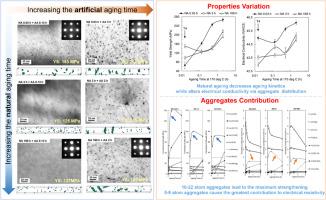自然时效对Al-Mg-Si-Cu合金早期时效响应的影响
IF 14.3
1区 材料科学
Q1 MATERIALS SCIENCE, MULTIDISCIPLINARY
引用次数: 0
摘要
高性能6xxx铝合金是汽车轻量化的关键材料,但在储存和运输过程中,它们不可避免地会经历自然老化,在此过程中,溶质聚集体形成并影响随后的沉淀行为。本研究利用三维原子探针(3dp)将溶质聚集体划分为5个尺寸类别,并通过微观结构表征和基于模型的性能分析来研究它们对早期人工老化的影响。结果表明,自然老化降低了人工老化动力学,即未经过自然老化的样品在0.13 h内迅速形成大聚集体(>;225原子),而经过自然老化的样品则明显延迟到2 h左右。含有10-22个原子的聚集体对强化的贡献最大,而中等大小的聚集体(23-75个原子)对早期老化的贡献最小。此外,较小的聚集体(5-9个原子)对电阻率的影响最大,随着自然老化时间的增加,这些聚集体的数量分数增加,导致电导率下降。精制降水序列在未到法定饮酒年龄的条件下提出:瑞士 → co-clusters 5 - 9 → co-clusters 10-22 → co-clusters 23 - 75 → 区76 - 225年 → β”沉淀在225年。这些见解强调了总体控制在定制老化响应和减轻汽车铝合金自然老化的不利影响方面的重要性。本文章由计算机程序翻译,如有差异,请以英文原文为准。

Effect of natural ageing on the early-stage ageing response of an Al-Mg-Si-Cu alloy
High-performance 6xxx aluminium alloys are critical materials for automotive lightweighting, but they inevitably undergo natural ageing during storage and transportation, during which solute aggregates form and influence subsequent precipitation behavior. In this study, three-dimensional atom probe (3DAP) was used to classify solute aggregates into five size categories, and their impact on early-stage artificial ageing was investigated through microstructural characterisation and model-based property analysis. Results show that natural ageing decreases artificial ageing kinetics, i.e., large aggregates (>225 atoms) form rapidly within 0.13 h in samples without prior natural ageing, which are significantly delayed to about 2 h in samples with prior natural ageing. Aggregates containing 10–22 atoms provide the greatest contribution to strengthening, while aggregates of intermediate size (23–75 atoms) contribute the least during the early ageing. Additionally, smaller aggregates (5–9 atoms) have the greatest impact on resistivity, and as natural ageing time increases, the number fraction of these aggregates increases, leading to a decrease in electrical conductivity. A refined precipitation sequence in under-aged conditions is proposed as: SSSS → co-clusters 5–9 → co-clusters 10–22 → co-clusters 23–75 → zones 76–225 → β'' precipitates >225. These insights highlight the importance of aggregate control in tailoring ageing response and mitigating the adverse effects of natural ageing in automotive aluminium alloys.
求助全文
通过发布文献求助,成功后即可免费获取论文全文。
去求助
来源期刊

Journal of Materials Science & Technology
工程技术-材料科学:综合
CiteScore
20.00
自引率
11.00%
发文量
995
审稿时长
13 days
期刊介绍:
Journal of Materials Science & Technology strives to promote global collaboration in the field of materials science and technology. It primarily publishes original research papers, invited review articles, letters, research notes, and summaries of scientific achievements. The journal covers a wide range of materials science and technology topics, including metallic materials, inorganic nonmetallic materials, and composite materials.
 求助内容:
求助内容: 应助结果提醒方式:
应助结果提醒方式:


